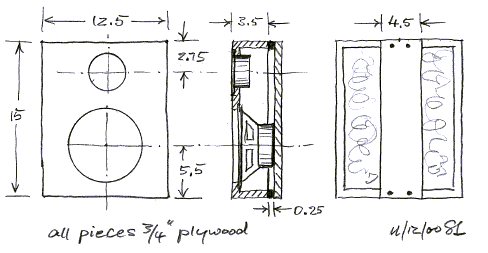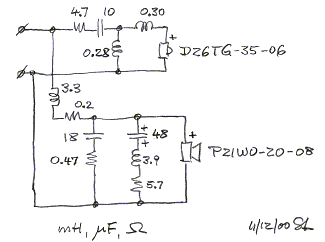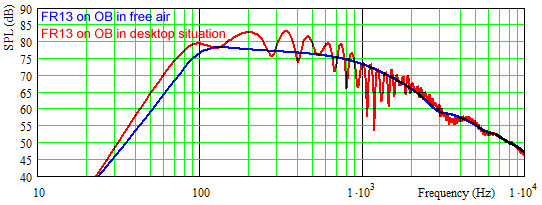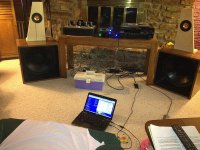Hello to all,
Maybe I should clarify something. When I say open-baffle I mean 'unboxed speaker', you can use a flat baffle, U or H, or any other 'open-baffle' style.
No sealed, reflex, horn, o any other 'box' type.
Please, at least other desing in addition to that using the Visaton FR13 (thanks Rudolf!) with a maximum of 6" speaker.
Thanks to all.
Maybe I should clarify something. When I say open-baffle I mean 'unboxed speaker', you can use a flat baffle, U or H, or any other 'open-baffle' style.
No sealed, reflex, horn, o any other 'box' type.
Please, at least other desing in addition to that using the Visaton FR13 (thanks Rudolf!) with a maximum of 6" speaker.
Thanks to all.
I like to avoid big chokes when possible too. What about line level bass shelving EQ with an op amp? Or line level high pass or low pass for the XO? I guess that gets into the analog processor territory and can get complicated fast. A mini DSP can work too.

This is Filter Pro . It is now freeware . The DOS version was wonderful . Wish I had a copy . The new one has many more options . This is a 60 Hz two pole with gain of 5 linear phase with minimal ripple . Choose E24 resistors to get easiest version to build . You can change caps to make it easier .
Raul,
I am not trying to be difficult just for the sack of being difficult. I'm trying to point out that you are not going to get a successful set of speakers if you insist of OB. You have heard OB speakers and you like the sound. Great. The problem is that you cannot do OB with the speakers hard against the wall and one in a corner. The sound of an OB has very little to do with the lack of a surrounding box and everything to do with dipole response. But to get the dipole response, you need significant space behind the speakers for the dipole figure-8 pattern to develop. You don't have it. the entire right side of the left speaker is blocked by the wall, and the right speaker crammed unto a corner is going to respond more like an ill-tuned bass reflex.
A speaker in a box does not need to sound boxy. I've been building speakers for 20 years, and they don't sound boxy. They sound different from OB's, but not boxy. And yes, I have played with OB's. Here is an OP with the Mark Audio A7.3 over an H-baffle.
Bob
I am not trying to be difficult just for the sack of being difficult. I'm trying to point out that you are not going to get a successful set of speakers if you insist of OB. You have heard OB speakers and you like the sound. Great. The problem is that you cannot do OB with the speakers hard against the wall and one in a corner. The sound of an OB has very little to do with the lack of a surrounding box and everything to do with dipole response. But to get the dipole response, you need significant space behind the speakers for the dipole figure-8 pattern to develop. You don't have it. the entire right side of the left speaker is blocked by the wall, and the right speaker crammed unto a corner is going to respond more like an ill-tuned bass reflex.
A speaker in a box does not need to sound boxy. I've been building speakers for 20 years, and they don't sound boxy. They sound different from OB's, but not boxy. And yes, I have played with OB's. Here is an OP with the Mark Audio A7.3 over an H-baffle.
Bob
Attachments
> (I don't recommend to have the OB pushed into a corner like the right one)
If you put both (high-Q (Fs~100,Qts~2))drivers on one ~2' wide x 1' high baffle
and have it accross the corner, you will get good response.
Suggested driver:
http://ep.yimg.com/ty/cdn/cam-electronics/S86WB8s.pdf
If you put both (high-Q (Fs~100,Qts~2))drivers on one ~2' wide x 1' high baffle
and have it accross the corner, you will get good response.
Suggested driver:
http://ep.yimg.com/ty/cdn/cam-electronics/S86WB8s.pdf
In a way it is easy to disprove that ( #63 ) . It was called a radio . As someone pointed out the speaker also cooled the tubes . The study of how to get the best sound was a practiced art . A French paper on it stressed the mutual benefits of the cooling , the speaker also must not get too hot . It also showed the tighter fitting side walls had a better response if not too deep !!! The writer said it took many experiments to get optimum sound . I was walking in Totnes Devon one day when greeted by vibrant sound . It was a Bush radio of the more compact type . It was filling the street ! A church jumble sale . £30 . Like a fool I didn't buy it . Ivory white Bakelite and immaculate . Circa 1948 .
As said earlier a drive unit for OB can be an excellent IB . AR virtually were doing that . I believe this gentleman said he would have a sub woofer to supplement the bass ? The advantage of no box is no reflected sound through the cones . That must be worth having ? I dare say if 250 Hz is the realistic lower limit this project is possible .
Also if successful these can be top units for a larger speaker in the future . Twin subs are better .
Found the French article . Reading it again he is saying radio stations , monitor speakers I guess ? No matter , it inspired me to think radios . I love the idea that there is an acoustic short circuit at the critical frequency . The French very often have good engineering terms ( Candles for spark plugs is a favorite , A Chauffeur heated the glow plugs or candles , he heated them which is his name , that was in the era of wick carburetors ) . The author is saying you can have have it all if you try hard enough . If it fails you are 90% to a sealed box .

As said earlier a drive unit for OB can be an excellent IB . AR virtually were doing that . I believe this gentleman said he would have a sub woofer to supplement the bass ? The advantage of no box is no reflected sound through the cones . That must be worth having ? I dare say if 250 Hz is the realistic lower limit this project is possible .
Also if successful these can be top units for a larger speaker in the future . Twin subs are better .
Found the French article . Reading it again he is saying radio stations , monitor speakers I guess ? No matter , it inspired me to think radios . I love the idea that there is an acoustic short circuit at the critical frequency . The French very often have good engineering terms ( Candles for spark plugs is a favorite , A Chauffeur heated the glow plugs or candles , he heated them which is his name , that was in the era of wick carburetors ) . The author is saying you can have have it all if you try hard enough . If it fails you are 90% to a sealed box .

Last edited:
Hello Mr. Bob Brines,
Thanks for your explanation, I think I had understood from the beginning, who may not be properly explained are me.
In the first post I put a picture of a desk, but not my desktop. I just put the photo how speakers example, my desktop is not near any corner, so there is no problem with this with the speakers.
Also I put this link:
Dual HS 15 + P 44 Service
I have speakers how these and I like the sound. I do not need more 'quantity', what I want is a design with more sound quality as these were very basic speakers, I guess today will be made better.
I have other small speakers that could be used how to 'desktop', are much more expensive, are bass-reflex, and I like less than the open-baffles of the old Dual turntable.
The bass (in extension) that giving the small Dual are enough for me to use that I want to, but what I want is a better sound with more refinement. If the people from Dual could do over 30 years ago, I guess today will be made better.
The design with the Visaton FR13 suppose to be something better than of Dual, though perhaps rather an equivalent. Just looking for something of better quality.
Thanks to all.
Thanks for your explanation, I think I had understood from the beginning, who may not be properly explained are me.
In the first post I put a picture of a desk, but not my desktop. I just put the photo how speakers example, my desktop is not near any corner, so there is no problem with this with the speakers.
Also I put this link:
Dual HS 15 + P 44 Service
I have speakers how these and I like the sound. I do not need more 'quantity', what I want is a design with more sound quality as these were very basic speakers, I guess today will be made better.
I have other small speakers that could be used how to 'desktop', are much more expensive, are bass-reflex, and I like less than the open-baffles of the old Dual turntable.
The bass (in extension) that giving the small Dual are enough for me to use that I want to, but what I want is a better sound with more refinement. If the people from Dual could do over 30 years ago, I guess today will be made better.
The design with the Visaton FR13 suppose to be something better than of Dual, though perhaps rather an equivalent. Just looking for something of better quality.
Thanks to all.
I forgot to say . The Quad ESL 57 is considered a classic OB or dipole speaker . In fact not exactly . There is a material like carpet felt in the back . Some people remove it if they have the larger room and use it as a true dipole . You see there are many steps to OB . It is like loving a dog . It doesn't have to be pedigree . That doesn't mean have a cat instead .

This is Filter Pro . It is now freeware . The DOS version was wonderful . Wish I had a copy . The new one has many more options . This is a 60 Hz two pole with gain of 5 linear phase with minimal ripple . Choose E24 resistors to get easiest version to build . You can change caps to make it easier .
Thanks for the tip on Filterpro. Akabak has the ability to simulate filter networks with resistors, caps, coils, and op amps too. You can actually put a crossover right into the driver connection. Maybe use this to develop values then put in akabak as it is script and not interactive.
raul_77, Bob is off course right, but do not give up yet, you can have cake and eat it too...have small open baffles on the desktop (from ~150Hz up) and one big closed box subwoofer (or two) under the table
Sim of Linkwitz PMT-1 OB
I think I finally managed to sim the Linkwitz PMT-1 dipole (open baffle) speaker Dipole protos:

It was interesting to be able to add a crossover as shown here:

directly into the circuit and see its effect on the woofer and tweeter outputs and then see the combined output. I don't have the shelving EQ function yet to remove the -6dB/oct roll-off yet. It has a nice response otherwise and Linkwitz built in a gradual rol-loff on the high end to compensate for roll-off on the low end - to balance it out as perceived by our ears.
I implemented the XO in AkAbak as follows:
The first plot is the freq response with the baffle mounted on a 30 in tall stand and placed 3 ft from a back wall. The second plot shows the baffle sitting on a flat surface like a desk and 24 in from the back wall. As you can see, when placed too close to back wall and flat on desk or floor, there are some undesirable effects to the response.
I think I finally managed to sim the Linkwitz PMT-1 dipole (open baffle) speaker Dipole protos:

It was interesting to be able to add a crossover as shown here:

directly into the circuit and see its effect on the woofer and tweeter outputs and then see the combined output. I don't have the shelving EQ function yet to remove the -6dB/oct roll-off yet. It has a nice response otherwise and Linkwitz built in a gradual rol-loff on the high end to compensate for roll-off on the low end - to balance it out as perceived by our ears.
I implemented the XO in AkAbak as follows:
Code:
| XO Circuit for Linkwitz PMT-1 Dipole Speaker, Aug 3, 2013
| For Vifa P21W0-20-08 8 in Woofer and Vifa D26TG-35-06 Dome Tweeter
| Amp input goes to nodes 1=0
Resistor 'R1' Node=1=2 R=10ohm | Default 4.7 ohm by SL
Capacitor 'C1' Node=2=3 C=10uF
Coil 'L1' Node=3=4 L=0.3mH
Coil 'L2' Node=3=0 L=0.28mH
| Tweeter goes to nodes 0=4 reverse polarity to flip phase
Coil 'L3' Node=1=6 L=3.3mH
Resistor 'R2' Node=6=7 R=0.2ohm
Capacitor 'C2' Node=7=8 C=18uF
Capacitor 'C3' Node=7=9 C=48uF
Coil 'L4' Node=9=10 L=3.9mH
Resistor 'R3' Node=10=0 R=5.7ohm
Resistor 'R4' Node=8=0 R=0.47ohmThe first plot is the freq response with the baffle mounted on a 30 in tall stand and placed 3 ft from a back wall. The second plot shows the baffle sitting on a flat surface like a desk and 24 in from the back wall. As you can see, when placed too close to back wall and flat on desk or floor, there are some undesirable effects to the response.
Attachments
This is an idea which could be made to work . The magnet is the problem . Wharfedale used a tile something like Linoleum ( Victorian plastic made from linseed ) . In the material was magnetic powder . Holes were punch in it to allow sound through .

I wondered if the magnets here could be used ? Holes one side , discs the other ?
Flexible Magnetic Dots | First4magnets.com

I wondered if the magnets here could be used ? Holes one side , discs the other ?
Flexible Magnetic Dots | First4magnets.com
Are you talking about planar membrane speakers? There is a whole forum on that and the most efficient way is to use perf steel plate on back with thin flat NdFeB magnets in between with a Mylar membrane stretched like a drum over a trapezoidal shaped frame on top. Drive with a transformer stepped up voltage. http://www.diyaudio.com/forums/planars-exotics/95541-full-range-planar-speaker-using-neo-magnets.html
It is worth a thought . For this project it would be go supersonic without bothering to look at paper comes . Full range is a bit like a bi plane usually .
I answered to this question:I do not know how Rudolf is able to achieve a frequency response that doesn't start to roll-off until 100 Hz with the FR13 as show here.

Doesn't seem to agree with the measurements by Linkwitz, or with my AkAbak sims which show falloff occurring in the range above 500 Hz. A flat response down to 100 Hz would normally require a closed box to isolate the back wave from cancelling with the front wave. ...
Am I missing something here?
In http://www.diyaudio.com/forums/full-range/240012-small-open-baffle-2.html#post3579062 I have shown what can be achieved with that driver and what not. Because of its high Qts and the support of the 3.3 mH coil at the driver resonance, the response will be flat down to 100 Hz.Please, if anyone has any open-baffle design with Visaton FR13-4 post it here.
I have also clearly shown how the ability to deliver SPL values rolls off from 500 Hz and precipitates below 200 Hz. This is the best result you can achieve with such a driver in a baffle of the given size.
If your results don't agree with the two independent sims of mine, you need to look into your AkAbak. I'm absolutely sure that my sims are in line with Linkwitz' theory.
I'm completely in line with above comment - except the 400 Hz value. Would be 200 Hz in this case. But this has been clear already in post #13.So what I am seeing is that with a single 5 or 6 in full range driver, you will need a bass driver (not even a sub woofer) to make it sound balanced if you like to hear bass below 400 Hz. Without any EQ'ing, the output from an OB, is, well very colored to the HF.
Rudolf
Hello Rudolf, welcome!
Please, a second design of small open-baffle with a higher quality speaker?
Anticipated thanks. Best regards.
Please, a second design of small open-baffle with a higher quality speaker?
Anticipated thanks. Best regards.
Rudolf,
I missed the fact that your sim has a 3.3mH inductor and big resistor to attenuate the HF. Ok that seems to make sense I will out that in. A 3.3 mH coil will cost as much as 5 of these drivers! Now there is not much above 2kHz so it will need a tweeter and XO?
I missed the fact that your sim has a 3.3mH inductor and big resistor to attenuate the HF. Ok that seems to make sense I will out that in. A 3.3 mH coil will cost as much as 5 of these drivers! Now there is not much above 2kHz so it will need a tweeter and XO?
Last edited:
Did you see that 1Lbs 19 AWG = approximately 5 mH . DCR 1.5 R which is not a problem if 8R drive unit . UK cost about < $15 . Parts Express have good prices in USA ( $20 or less ) . DCR of 0.3 R not required .
The amplifier with EQ passed it's first test . It has made them all laugh in the link below . Now to refine it . It is already good enough for my use . If we were to use is full range it needs work . It was an old cheap PA amp . PCB when proven . 5 transistors only and 100 watts .
http://www.diyaudio.com/forums/lounge/200865-sound-quality-vs-measurements-204.html#post3584400
The amplifier with EQ passed it's first test . It has made them all laugh in the link below . Now to refine it . It is already good enough for my use . If we were to use is full range it needs work . It was an old cheap PA amp . PCB when proven . 5 transistors only and 100 watts .
http://www.diyaudio.com/forums/lounge/200865-sound-quality-vs-measurements-204.html#post3584400
A 3.3 mH coil will cost as much as 5 of these drivers!
Not so expensive, and surely can be found cheaper:
1x LAUTSPRECHER-DROSSEL SPULE 3,3mH 7460/66 | eBay
I believe that you don't want to look into the 20cm and plus class for a "small" design. Below that I see only two other candidates:Hello Rudolf, welcome!
Please, a second design of small open-baffle with a higher quality speaker?
Anticipated thanks. Best regards.
The Ciare HX135 is the only "high quality" driver if you judge from material and price. The
Sica LP165.25/280 ER is a bit larger than the FR13, but still a steel basket driver only. There aren't any more candidates I know of.
Just tell me for which one of these drivers you like to see my design proposal. 🙂
Rudolf
This would almost be ideal . I have heard these KEF's sound like electrostatic speakers . I suspect even though a mid range it would be OK if the sub 50 Hz was filtered to stop the cone moving too far .
http://medleysmusings.com/kef-r300-midrange-drive-unit-testing/
http://medleysmusings.com/kef-r300-midrange-drive-unit-testing/
- Status
- Not open for further replies.
- Home
- Loudspeakers
- Full Range
- Small open-baffle?


